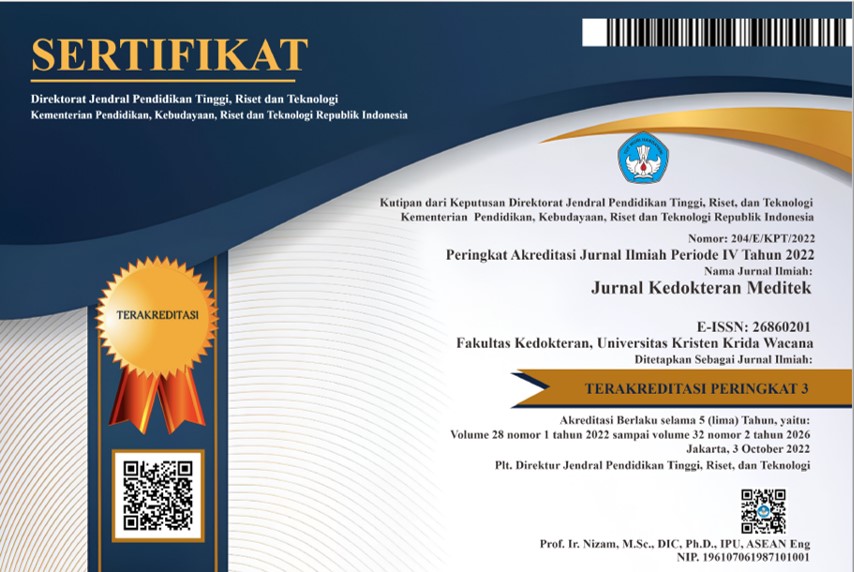Correlation of Uric Acid Levels with Lipid Profile among MCU Patients
DOI:
https://doi.org/10.36452/jkdoktmeditek.v31i1.3297Keywords:
uric acid, HDL, LDL, triglycerides, total cholesterolAbstract
Introduction: Uric acid (C5H4N4O3) is a product of purine degradation and can act as a pro-oxidant substance because of the formation of ROS through the enzymatic activity of xanthine oxidase. Previous research has shown that uric acid can affect lipid metabolism in the body. Purpose: This study aims to explore the relationship between lipid profiles in MCU patients and uric acid levels. This study employs a cross-sectional design, and we will analyze the data using linear regression. Methods: This study is an observational analytic study without intervention, using a cross-sectional study design. The research data came from secondary data, especially the medical records of MCU patients. Researchers selected the study sample using a random sampling technique. The study uses 86 secondary data samples. Results: Linear regression analysis reveals a significant positive correlation between uric acid and triglycerides (p-value < 0.001 and r = 0.464), total cholesterol (p-value = 0.018 and r = 0.255), and LDL (p-value = 0.011 and r = 0.273). A significant negative correlation exists between uric acid levels and HDL (p-value < 0.001 and r = 0.477). Increased uric acid levels are associated with higher levels of TG, TC, and LDL, as well as a decrease in HDL levels. The average levels of LDL and total cholesterol are 140.27 mg/dl and 206.66 mg/dl, respectively, which are at the high threshold, while all other variables are within normal limits. Conclusion: This study concludes that uric acid levels and lipid profile levels are significantly related
References
Budreviciute A, Damiati S, Sabir DK, Onder K, Schuller-Goetzburg P, Plakys G, et al. Management and Prevention Strategies for Non-communicable Diseases (NCDs) and Their Risk Factors. Front Public Health. 2020 Nov 26;8:574111. Available from: https://doi.org/10.3389/fpubh.2020.574111
Feingold KR, Grunfeld C. Effect of inflammation on HDL structure and function. Curr Opin Lipidol. 2016 Oct;27(5):521–30. Available from: https://doi.org/10.1097/MOL.0000000000000333
Spiga R, Marini MA, Mancuso E, Di Fatta C, Fuoco A, Perticone F, et al. Uric Acid Is Associated With Inflammatory Biomarkers and Induces Inflammation Via Activating the NF-κB Signaling Pathway in HepG2 Cells. Arterioscler Thromb Vasc Biol. 2017 Jun;37(6):1241–9. Available from: https://www.ahajournals.org/doi/10.1161/ATVBAHA.117.309128
Lu W, Xu Y, Shao X, Gao F, Li Y, Hu J, et al. Uric Acid Produces an Inflammatory Response through Activation of NF-κB in the Hypothalamus: Implications for the Pathogenesis of Metabolic Disorders. Sci Rep. 2015 Jul 16;5(1):12144. Available from: https://doi.org/10.1038/srep12144
Bayu Paramartha IGN, Gita Pranata Putra IGB, Ratna Dew S. Hubungan antara Kadar Asam Urat dengan Profil Lipid pada Pasien Sindrom Koroner Akut di RSUD Sanjiwani Gianyar. AMJ (Aesculapius Medical Journal) 2023;3:284–91. Available from: https://doi.org/10.22225/amj.3.3.2023.284%20-%20291 .
Yudha Pratama M, Sugiarto S, Weni L, Arsyad M. Hubungan Hiperurisemia Dengan Profil Lipid Pada Pasien Poliklinik Penyakit Dalam Di Rumah Sakit Pusat Angkatan Darat Gatot Soebroto Periode 1 Januari 2019 – 31 Desember 2021 Dan Tinjauannya Menurut Agama Islam. Maj Sainstekes. 2023 Aug 3;10(1):001–18. Available from: https://doi.org/10.33476/ms.v10i1.3269
Halperin Kuhns VL, Woodward OM. Sex Differences in Urate Handling. Int J Mol Sci. 2020 Jun 16;21(12):4269. Available from: https://doi.org/10.3390/ijms21124269
Suwanchatchai C, Khuancharee K, Tanunyutthawongse C, Wannaiampikul S, Haetanurak P. Sex Difference in the Prevalence and Associations among Hyperuricemia Adults in Rural Thailand: a Population-Based Cross-Sectional Study [Internet]. 2023 [cited 2024 Jun 22]. Available from: https://www.researchsquare.com/article/rs-2812206/v1. https://doi.org/10.21203/rs.3.rs-2812206/v1
Tsai MK, Hung KC, Liao CC, Pan LF, Hung CL, Yang DH. The Association between Serum Testosterone and Hyperuricemia in Males. J Clin Med. 2022 May 12;11(10):2743. Available from: https://doi.org/10.3390/jcm11102743
Zheng R, Ren P, Chen Q, Yang T, Chen C, Mao Y. Serum Uric Acid Levels and Risk of Incident Hypertriglyceridemia: A Longitudinal Population-based Epidemiological Study. Ann Clin Lab Sci. 2017 Sep;47(5):586–91. Available from: http://www.annclinlabsci.org/content/47/5/586.long
Tan MY, Mo CY, Li F, Zhao Q. The association between serum uric acid and hypertriglyceridemia: evidence from the national health and nutrition examination survey (2007–2018). Front Endocrinol. 2023 Jul 18;14:1215521. Available from: https://doi.org/10.3389/fendo.2023.1215521
Chen S, Yang H, Chen Y, Wang J, Xu L, Miao M, et al. Association between serum uric acid levels and dyslipidemia in Chinese adults: A cross-sectional study and further meta-analysis. Medicine (Baltimore). 2020 Mar;99(11):e19088. Available from: https://doi.org/10.1097/MD.0000000000019088
Ali N, Rahman S, Islam S, Haque T, Molla NH, Sumon AH, et al. The relationship between serum uric acid and lipid profile in Bangladeshi adults. BMC Cardiovasc Disord. 2019 Dec;19(1):42. Available from: https://doi.org/10.1186/s12872-019-1026-2
Moriyama K. HDL cholesterol subclasses are associated with serum uric acid in Japanese men. Health Eval Promot. 2018 Jul 10;45(4):563–8. Available from: https://doi.org/10.7143/jhep.45.563
Lim S, Moon N. Relationship between Serum Uric Acid Level and Low-Density Lipoprotein Cholesterol in Korea Adults: Korea National Health and Nutrition Examination Survey 2017. Korean J Fam Pract. 2020 Jun 20;10(3):208–14. Available from: https://doi.org/10.21215/kjfp.2020.10.3.208
Kuwabara M, Borghi C, Cicero AFG, Hisatome I, Niwa K, Ohno M, et al. Elevated serum uric acid increases risks for developing high LDL cholesterol and hypertriglyceridemia: A five-year cohort study in Japan. Int J Cardiol. 2018 Jun;261:183–8. Available from: https://doi.org/10.1016/j.ijcard.2018.03.045
Sarmah D, Sharma B. A correlative study of uric acid with lipid profile. Asian J Med Sci. 2013 May 12;4(2):8–14. Available from: https://doi.org/10.3126/ajms.v4i2.7893
Smith E, March L. Global Prevalence of Hyperuricemia: A Systematic Review of Population-Based Epidemiological Studies [abstract]. Arthritis Rheumatol. 2015; 67 (suppl 10). https://acrabstracts.org/abstract/global-prevalence-of-hyperuricemia-a-systematic-review-of-population-based-epidemiological-studies/. Accessed June 22, 2024. Available from: https://doi.org/10.1002/art.39448
Liu T, Zhao D, Qi Y. Global Trends in the Epidemiology and Management of Dyslipidemia. J Clin Med. 2022 Oct 28;11(21):6377. Available from: https://doi.org/10.3390/jcm11216377
Mcpherson RA, Pincus MR. Henry’s Clinical Diagnosis and Management by Laboratory Methods. 23rd ed. St. Louis, Missouri: Elsevier; 2017. p. 436.
Downloads
Published
How to Cite
Issue
Section
License
Copyright (c) 2025 Aghnia Hidayah, Freddy Ciptono

This work is licensed under a Creative Commons Attribution-ShareAlike 4.0 International License.

















